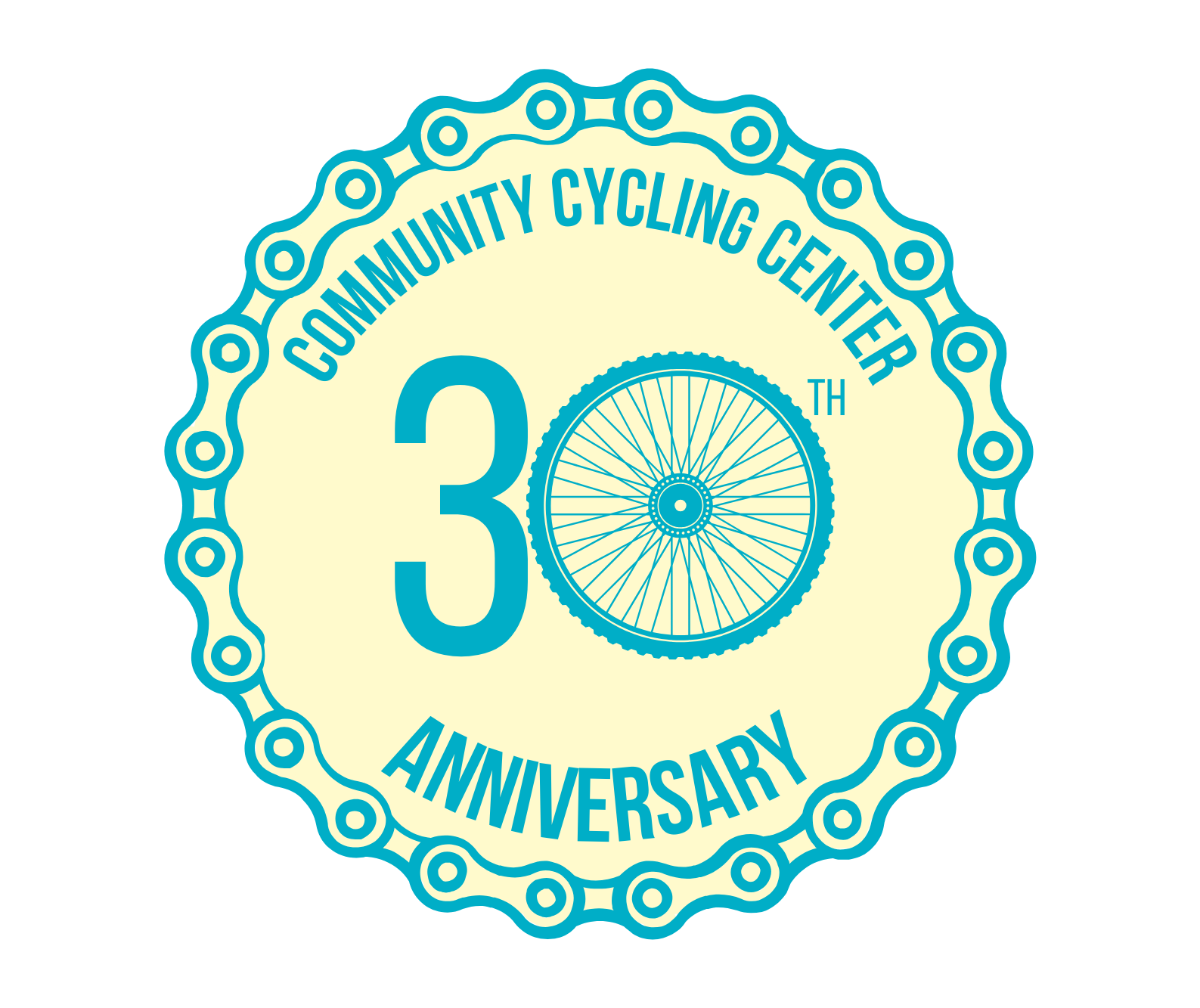Shop tip: oil, grease, and solvents, what to use where
By Patrick Loftus, Service Manager
The most common question we get in the shop is, “What do I use to oil my chain?” This month’s shop tip covers different oils, greases, and solvents and their best uses.
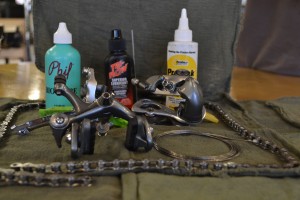 Light Oil – TriFlow ($5), Phil Wood’s Bio Lube ($10), and Prolink are just a few examples of light oil that we carry in the shop, but there are plenty more options out there. Light oils are great for chains, derailleur pivots, derailleur pulleys while they’re attached to the bike, brake pivots, and already installed cables. Before you lube anything make sure to wipe off as much dirt as possible. The lube will loosen up more grime, so be sure to wipe off excess oil when you’re done. If you only have one type of lube at home, it should be light oil.
Light Oil – TriFlow ($5), Phil Wood’s Bio Lube ($10), and Prolink are just a few examples of light oil that we carry in the shop, but there are plenty more options out there. Light oils are great for chains, derailleur pivots, derailleur pulleys while they’re attached to the bike, brake pivots, and already installed cables. Before you lube anything make sure to wipe off as much dirt as possible. The lube will loosen up more grime, so be sure to wipe off excess oil when you’re done. If you only have one type of lube at home, it should be light oil.
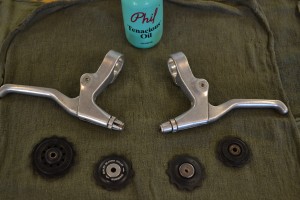 Heavy Oil – Phil Wood’s Tenacious oil ($10) is one of the lesser celebrated bike lubricants. Truth be told, it’s an odd one to tell people how to use. It can be hard to get heavy oil into tight places, so I like using it in many of the same places as light oil, but when the parts are freshly overhauled and/or off the bike. Heavy oil can work well on brand new cables and freshly overhauled derailleur pulleys or brake pivots. If you ride a single speed or internally geared hub and forget to lube your chain throughout the winter, Tenacious oil can work great as it will last longer than light oil. Avoid using it on your chain if your bike has a derailleur, as it will gunk things up faster. Again, wipe off the excess after you use it.
Heavy Oil – Phil Wood’s Tenacious oil ($10) is one of the lesser celebrated bike lubricants. Truth be told, it’s an odd one to tell people how to use. It can be hard to get heavy oil into tight places, so I like using it in many of the same places as light oil, but when the parts are freshly overhauled and/or off the bike. Heavy oil can work well on brand new cables and freshly overhauled derailleur pulleys or brake pivots. If you ride a single speed or internally geared hub and forget to lube your chain throughout the winter, Tenacious oil can work great as it will last longer than light oil. Avoid using it on your chain if your bike has a derailleur, as it will gunk things up faster. Again, wipe off the excess after you use it.
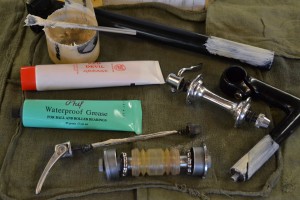 Grease – We carry Phil Wood’s Waterproof Grease ($10) and Red Devil grease ($8) in the shop, but tend to use white lithium grease because we can buy it in bulk. Grease is most commonly used in bearing assemblies, such as hubs, bottom brackets, and headsets. If you have a grease gun (something with a long pointy nozzle) you can add grease between major service intervals by carefully opening the assembly and squirting fresh grease in, otherwise it’s best to fully disassemble and clean the parts before adding fresh grease. Grease is also great when assembling a bike. Use it on quill stems, seat posts, bolts, and pretty much anywhere metal touches metal to prevent creaking and seizing. Don’t use grease on any carbon parts. There are carbon assembly pastes available. Check your owner’s manual to see what the manufacturer recommends.
Grease – We carry Phil Wood’s Waterproof Grease ($10) and Red Devil grease ($8) in the shop, but tend to use white lithium grease because we can buy it in bulk. Grease is most commonly used in bearing assemblies, such as hubs, bottom brackets, and headsets. If you have a grease gun (something with a long pointy nozzle) you can add grease between major service intervals by carefully opening the assembly and squirting fresh grease in, otherwise it’s best to fully disassemble and clean the parts before adding fresh grease. Grease is also great when assembling a bike. Use it on quill stems, seat posts, bolts, and pretty much anywhere metal touches metal to prevent creaking and seizing. Don’t use grease on any carbon parts. There are carbon assembly pastes available. Check your owner’s manual to see what the manufacturer recommends.
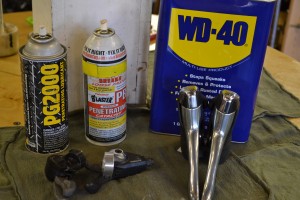 Solvent – In increasing strength, WD40, ProGold 2000, and PB Blaster are great for cleaning or getting stuck stuff unstuck. Contrary to common belief, WD40 is not a lube; it’s a solvent that’s good for cleaning things and will strip lubricants away. We use WD40 to lubricate seized spoke nipples and that’s about it. ProGold 2000 is primarily a solvent, but leaves a trace of oil behind. We use it to flush out sticky shifters or freewheels. PB Blaster is a catalyst that reacts to rust. We use it in the shop if a stem or seat post is really stuck in a frame. Use solvents as lightly as possible. They can damage paint, so be careful where you spray them and clean off painted surfaces using a mild detergent (Simple Green, 409, etc.). If you use a solvent on anything be sure to remove all traces before lubing. If you regularly lube your bike and wipe off the extra you won’t really need to use any solvents.
Solvent – In increasing strength, WD40, ProGold 2000, and PB Blaster are great for cleaning or getting stuck stuff unstuck. Contrary to common belief, WD40 is not a lube; it’s a solvent that’s good for cleaning things and will strip lubricants away. We use WD40 to lubricate seized spoke nipples and that’s about it. ProGold 2000 is primarily a solvent, but leaves a trace of oil behind. We use it to flush out sticky shifters or freewheels. PB Blaster is a catalyst that reacts to rust. We use it in the shop if a stem or seat post is really stuck in a frame. Use solvents as lightly as possible. They can damage paint, so be careful where you spray them and clean off painted surfaces using a mild detergent (Simple Green, 409, etc.). If you use a solvent on anything be sure to remove all traces before lubing. If you regularly lube your bike and wipe off the extra you won’t really need to use any solvents.
General lubrication tips – Any time you lube something, it’s good to give it a good wipe down before and after lube is applied. Use any lubes or solvents sparingly. If you over lube something it will just attract dirt, so be sure to wipe off the excess. If you use too much solvent it will prevent lube from getting in where it needs to.
If you have any questions about how to lube various parts of your bike or want to see what oils and grease we have in stock, stop by our bike shop and speak to one of our friendly mechanics.
